

Faut-il travailler avec un métronome ? Faut-il travailler avec un métronome ?
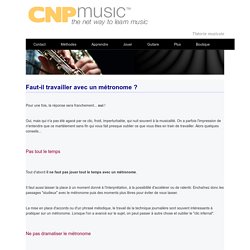
Pour une fois, la réponse sera franchement... oui ! Oui, mais qui n'a pas été agacé par ce clic, froid, imperturbable, qui nuit souvent à la musicalité. On a parfois l'impression de n'entendre que ce martèlement sans fin qui vous fait presque oublier ce que vous êtes en train de travailler. Alors quelques conseils... Pas tout le temps Tout d'abord il ne faut pas jouer tout le temps avec un métronome. Il faut aussi laisser la place à un moment donné à l'interprétation, à la possibilité d'accélérer ou de ralentir. La mise en place d'accords ou d'un phrasé mélodique, le travail de la technique journalière sont souvent intéressants à pratiquer sur un métronome. Ne pas dramatiser le métronome Il ne faut surtout pas être obnubilé par le fait de jouer parfaitement sur les battements. il faut essayer de jouer (s'amuser) avec le métronome et ne pas le subir.
Improvisation - Les substitutions d'accords - les cours de guitare - Indy Musics. 1 - Rappel sur les intervalles Allez nous allons refaire un peu d'harmonie pour comprendre les substitutions et revoir un peu les renversements.
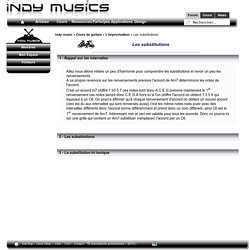
A ce propos revenons sur les renversements prenons l'accord de Am7 déterminons les notes de l'accord. C'est un accord m7 chiffré 1 b3 5 7 ces notes sont donc A C E G prenons maintenant le 1er renversement ces notes seront donc C E G A hors ici si l'on chiffre l'accord on obtient 1 3 5 6 qui équivaut à un C6. On pourra affirmer qu'à chaque renversement d'accord on obtient un nouvel accord (ceci est du aux intervalles qui sont renversés aussi) c'est les même notes mais jouer avec des intervalles différents donc l'accord sonne différemment et prend donc un nom différent, ainsi C6 est le 1er renversement de Am7.
Intéressant non et ceci est valable pour tous les accords. DAN GOUJON. One String Solo in Amin Lesson. Hello GMC!
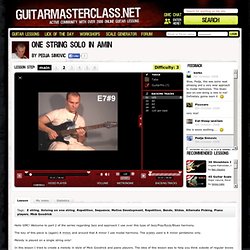
Welcome to part 2 of the series regarding Jazz and approach I use over this type of Jazz/Pop/Rock/Blues harmony. The key of this piece is (again) A minor, and around that A minor I use modal harmony. The scales used is A minor pentatonic only. Melody is played on a single string only! In this lesson I tried to create a melody in style of Mick Goodrick and piano players. When you finish this lesson hopefully you would have captured and mastered some of the following techniques: - Playing on a single string - Alternate picking - Rhythmic repetition - Syncopated rhythm - Motive development - Q & A type of phrasing - Develop your ear Equipment I used for recording my sound was: Custom built guitar (G.Papazoglou) with Pod X3 live going directly to computer.
Don't hesitate to contact me if you have any questions or comments related to this lesson. I look forward hearing from you all! Pedja Related lessons: 30 Shredders In One Solo Lesson. 45 Guitar Scales In One Solo Lesson. Welcome to a new lesson - all about scales!
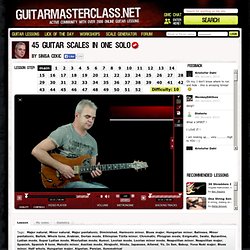
What is a Scale? - It is an ascending or descending series of notes where each note is referred to as a scale degree. Scales may be described as tonal, modal, diatonic, derived or synthetic, and by the number of tones included. The musical scale is based on octaves. Standard western scales have 12 notes per octave. On a side note, Non-Western (or Exotic, Eastern, Arab etc) scales, use tones half-way between western notes, leading to 24 notes. Although mathematics are involved in the sphere of music, nobody for sure knows how mathematical relationships work in relation to tones and scales. There are over 1000 musical scales worldwide, it is simply impossible to find and learn all, mostly because of different tunings and playing approaches. Many cultures use simple scales, two tones, three, four or five tones. Many of these scales have different names but the same tonality. Numbers indicate video parts in which the scale is shown: 1. Sinisa Cekic. Location:Serbia Date of Birth: November 10 1964 Been playing guitar since: 1979 My name is Sinisa Cekic.
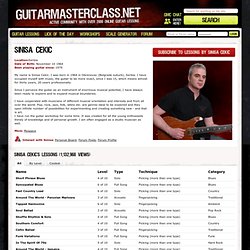
I was born in 1964 in Obrenovac (Belgrade suburb), Serbia. I have occupied myself with music, the guitar to be more exact, since I was 15, which means almost for thirty years, 20 years professionally. Since I perceive the guitar as an instrument of enormous musical potential, I have always been ready to explore and to expand musical boundaries. I have cooperated with musicians of different musical orientation and interests and from all over the world. More: Myspace Interact with Sinisa:Personal Board, Forum Posts, Forum Profile.